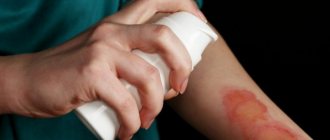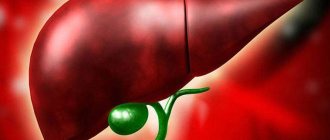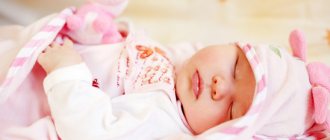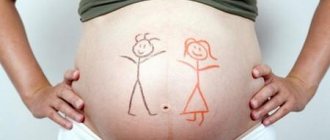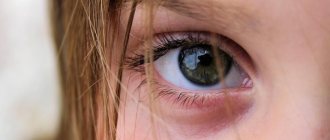A burn is an injury caused by close contact of the skin with hot objects or active chemicals. Determining the area of the burn is a necessary technique for determining the degree of injury and prescribing further treatment.
What are the types of burns in children?
Burns in young children can be caused by various reasons, depending on which the doctor determines their type.
Table 1. Types of burns
| Burn type | What caused it? |
| Thermal | Most common. Occurs as a result of child contact with boiling water, open fire, boiling oil or fat, or hot metal surfaces |
| Chemical | It does not occur often in everyday life; it occurs when interacting with acids or alkalis (sometimes when contacting aggressive detergents, bleaches). Also, special mention should be made of chemical burns of the esophagus, which occurs in children when they accidentally swallow batteries. |
| Electric | Occurs when a child is struck by an electric shock, which, unfortunately, is not so rare, especially if parents leave the child unattended or allow him to play with electrical appliances and plug them into a socket. |
| Solar | Such burns in children appear during prolonged exposure to open sunlight. |
Important! Regardless of the cause of burns in children, do not self-medicate and do not refuse hospitalization, since you will not be able to determine on your own how deeply the tissues are affected.
Depending on the depth of tissue damage, children's burns are divided into several degrees.
Table 2. Degrees of burns
| Degree of damage | What is it characterized clinically and visually? |
| First degree | Only the epidermis is damaged. This lesion is characterized by redness of the skin, burning, slight swelling and pain when trying to touch. |
| Second degree | The affected area of the epidermis completely dies; blisters filled with clear liquid immediately appear at the site of injury. |
| Third degree: A; B. | The deep layers of the skin are affected, large blisters filled with fluid and blood appear. Upon contact with a hot dry object or an open flame, a thick brown crust forms on the surface of the skin. |
| Fourth degree | All layers of skin and subcutaneous fatty tissue are damaged, as well as tendons, muscles, and in severe cases even bones - this is visually characterized by charring of the tissues |
Important! This classification of damage by severity is typical for thermal burns; for other types, other designations are used.
Treatment
In the hospital, the wound is washed with antiseptic substances, the blisters are opened, the damage is treated with healing ointment and a bandage is applied. If necessary, the child is given painkillers and drugs that increase immunity and reduce intoxication.
Pharmacy drugs
There are many medications available for healing burn wounds. Doctors recommend the following for a child:
- Panthenol. The spray contains an analogue of pantothenic acid, which improves metabolic processes. The product soothes pain, removes swelling and promotes tissue regeneration.
- Olazol. The drug in aerosol form contains sea buckthorn oil, boric acid, and chloramphenicol. The components accelerate the healing of wounds, eliminate irritation and prevent infection.
Aerosols are more convenient to use. To carry out the treatment, you need to shake the bottle, point it at the damage and press the dispenser. One or two pumps are enough for the foam to cover the burn. You should wait 10 minutes for the product to be absorbed and apply a bandage .
Antimicrobial ointments are needed to relieve inflammation. Children can use the following products:
- Levomekol. The composition contains chloramphenicol (a broad-spectrum antibiotic) and methyluracil, which accelerates cell regeneration. The medicine is applied in a thick layer and covered with a sterile bandage. Dressings should be done twice a day.
- Furacilin ointment. It is prescribed when a wound becomes infected. Apply the product to the lesions 2 times a day.
- Dermazin. The drug based on silver sulfadiazine has a restorative and anti-inflammatory effect. The wound should be smeared 3-4 times a day, and the medication should be applied under the bandage. It is worth considering that the ointment does not contain components for pain relief.
- Balm Rescuer. Natural ingredients quickly relieve pain, kill germs, and prevent the formation of scars. The balm can be used to treat any burns. Frequency: 3 times a day.
Before using the products, the epidermis must be disinfected. For this, solutions of manganese, Furacilin, Miramistin and Chlorhexidine are used.
It is good to treat sun and thermal burns of the 1st degree with Bepanten and La-Cri creams. They are made on the basis of dexpanthenol. The products cool, relieve burning and itching. Apply 2-3 times a day.
Traditional methods
Traditional medicine recipes are allowed in combination with traditional treatment for the treatment of minor childhood burns. Before use, it is important to consult a doctor so as not to harm the child’s health.
- Homemade ointment prepared according to this recipe has regenerating properties. You need to boil 3 eggs. Remove the yolk and mash thoroughly in a frying pan. Place on the stove, cover with a lid and heat until red drops of oil begin to come out of the yolk. They need to be collected, cooled and spread on the burn. Carry out the procedure 3 times a day.
- Compresses made from fresh vegetables soothe pain and irritation. You need to grate a potato tuber, carrot or beet. Wrap the pulp in gauze and place it on the injury site. Remove after half an hour. Repeat 2 times a day.
- Superficial burns go away faster if you apply aloe juice at night. The bottom leaf of the plant should be crushed, the juice squeezed out, soaked in gauze and applied to the affected areas. Instead, you can anoint the wound several times and wait for the juice to dry.
How long does it take for burns in children to heal?
The baby covered his face with his hands
Of course, parents who have encountered a similar injury in a child are concerned with the question: how long will it take for the burn to go away, and will there be any scars in its place?
It all depends on the severity of the damage:
- with a 1st degree thermal burn, all redness and unpleasant symptoms go away on their own after 2-3 days, leaving no changes on the child’s skin;
- for 2nd degree burns, the healing and recovery process lasts about a week, but even after complete tissue regeneration, the red mark may remain for several weeks;
- with 3a degree burns, the healing process takes about 1 month, no scars remain, but the trace of the injury remains for a long time; with 3b degree burns, the affected area does not heal for a long time, can become infected, and after healing a noticeable scar forms on the skin;
- With 4th degree burns, the patient needs a lot of time for rehabilitation; he undergoes more than one tissue transplant operation, and sometimes amputation of the affected limbs is performed.
Chemical burns
Child and detergents
In case of a chemical burn, when making a diagnosis, it is of great importance what kind of substance caused the injury - acid, alkali, lime, salts of heavy metals. In addition, pay attention to the concentration of the traumatic substance and the duration of its contact with the child’s skin.
Determining the severity of damage is in many ways similar to the classification of thermal burns, but the formation of blisters is not typical for chemical burns.
When the skin is burned with acid of 3-4 severity, a dense scab is formed on its surface, which is due to the coagulation (clotting) of proteins by the chemical substance. Thus, as if a protective reaction is triggered - the scab prevents the acid from penetrating even deeper into the tissue.
With an alkaline burn, a scab also forms, but it is loose and soft - this is characterized by the ability of alkalis to saponify fats and dissolve proteins, which allows the chemical to penetrate into the deepest layers of tissue.
Burns from alkalis are always much more severe than from acids. Chemical burns always leave deep scars on the surface and have a long rehabilitation process compared to thermal burns.
Electrical burns
Playing with sockets can be dangerous
This type of skin damage occurs as a result of the conversion of electrical energy into thermal energy. The most common cause of electrical burns is violation of the rules for using household appliances, which adults give to small children as toys and ignore.
The severity of such an injury depends on the voltage of the current and the duration of its contact with the child’s body - electrical burns are always deep and pose a threat to the baby’s life, affecting the brain and cardiovascular system.
Sunburn
Games under the scorching sun
They occur very often in pediatrics and are caused by the baby’s prolonged exposure to open sunlight without the use of sunscreen creams. Such skin lesions are characterized by redness, swelling, severe burning and increased body temperature.
After about 4-5 days, the skin on the affected areas of the body begins to peel off; in severe cases, pigment spots and even scars may form.
When is it necessary to see a doctor?
It is imperative to visit a specialist if:
- receiving a burn to a baby;
- damage to a large surface (when the size of the burned skin reaches the area of the victim’s palm or more);
- the presence of open wounds;
- receiving an injury to the head, lips, mouth or nose (in such a situation, the respiratory organs may be damaged);
- adhesion of clothing fabric to the skin;
- symptoms of stage II, III, IV burns in a child.
Blisters on the skin containing thick and dark liquid contents indicate an infection of the wound. You should not treat yourself in such a situation, as this will worsen the condition.
How to correctly determine the area of the burned surface for a child?
When an injured baby arrives at a children's burn center, doctors assess the severity of his condition depending on the area of the affected surface. The area of burns in children is calculated by two formulas - the rule of palms and the rule of nines (can be used separately, but most often simultaneously).
Palm rule
One palm – 1% of body surface
The palm of a person, in this case a child, is equal to approximately 1% of the entire surface of the body (regardless of age), which is why, by comparing the surface of a child’s palm with a burned surface, one can roughly judge what% of the body is affected.
Important! Injuries to the genital organs, perineum and esophagus are classified as shock injuries, so damage to these areas is equated to 10% of the burn area of the entire body. The larger the area affected, the more severe the condition of the victim and the higher the risk of developing a complication such as burn disease.
Rule of nines
Rule of nines for burns
The entire surface area of the body is divided into anatomical areas - head, neck, chest, abdomen, back, lower back, groin, limbs.
According to the rule of nines, the following meanings are used in medicine:
- head and upper limbs – 9%;
- thigh – 9%;
- lower limbs – 9%;
- back and stomach (the entire back and front surface of the body) - 18% each, that is, 36%;
- perineum – 1%.
Of course, for children under 12 years of age, the rule of nines is not very accurate in determining the affected surface, since in children the proportions of the head and torso are somewhat different. In the combustiology departments of the burn center, special tables are used to determine the percentage of damage, taking into account the age of the victim.
Possible consequences and complications
Damage of 1st and 2nd degrees, not exceeding 2% of the skin, rarely causes complications. Inflammation stops, injured cells are restored.
Sometimes pigment spots appear at the site of burns. They can be lubricated with lemon or orange juice to lighten them, or use Boro Plus cream or Radevit ointment.
Extensive grade 3 injuries can only be treated in a hospital. They lead to shock and burn disease. The course of the pathology is characterized by weakness, lethargy, and constant thirst. Urgent hospitalization and complex therapy aimed at reducing intoxication, restoring liver and kidney function, and tissue healing are required.
Deep burns leave scars and welts. To remove such consequences, the intervention of a plastic surgeon is often required.
What to do if a child has a burn: rules for providing emergency care
The principles of providing emergency first aid for burns in children differ depending on the cause of the injury.
Thermal burn: first aid
As mentioned earlier, thermal burns can be superficial (1st and 2nd degree) and deep (3.4). If a child has a small burn, what should you do in this case?
The algorithm of actions is as follows:
- Immediately eliminate the source of injury from the child - boiling water, open fire, boiling oil, etc.
- Free the affected area from clothing - this is where parents make the main mistake and begin to remove clothes over their heads, which is absolutely not allowed. When clearing the burn site from clothing in the usual way, you can damage the blisters with liquid, which will lead to complications and infection in the wound. Clothes should be cut with scissors. If a child is burned by a flame and the tissue on the body is on fire, the fire should be immediately extinguished with water. If the injury is deep and tissue is stuck to the burn site, then under no circumstances should you tear it off so as not to further damage the skin.
- Place the injury site under running cold water - this will help reduce pain.
- Be sure to give your child a painkiller (Panadol, Nurofen or any other) - babies are extremely sensitive, so any manipulation of the damaged area of skin without anesthesia can cause the development of painful shock.
- Treat the burn site with a special Panthenol spray.
Important! Do not lubricate the affected areas with oil, grease or any cream! If there is no Panthenol in the house, then we do not treat the burn with anything else.
Painkiller will reduce pain
How to properly treat a child’s burn with a deep injury?
The algorithm of actions is as follows:
- remove the child from the source of injury;
- free the injury site from clothing if possible - if the fabric is stuck, do not tear anything off by force;
- It is forbidden to open the formed blisters and clean the wound of liquid or blood on your own;
- give the child an anesthetic according to the attached instructions;
- Apply a dry, clean bandage to the affected area;
- Call an ambulance or go to the emergency room yourself.
In most cases, 2nd degree burns can be treated at home, but the child must be examined by a doctor. Parents are obliged to strictly follow all the specialist’s recommendations and properly care for the wound to prevent secondary infection.
If stage 3 damage is detected, treatment is possible on an outpatient basis if positive dynamics are observed, there are no complications, and the child’s general condition is not impaired. Therapy is based on the daily application of a closed gauze bandage, sterile, soaked in antiseptic solutions.
Most often, for a burn, a child is prescribed an aqueous solution of iodine Betadine, which is used to treat the affected area daily.
When opening blisters with liquid, in order to avoid infection or the addition of a secondary bacterial infection, the victim is prescribed a course of treatment with antibiotics, which are administered orally or by injection, depending on the severity of the injury.
Chemical burns: emergency care
Wash off the chemical before the doctor arrives
If a child comes into contact with a chemical, it should be immediately removed from the source of damage, and then remove clothing soaked in acid or alkali from the wound. Immediately place the damaged area under running cold water and keep it there for about an hour or until a doctor arrives.
The child must be given a painkiller to avoid painful shock. As a rule, burns caused by acids are neutralized with alkali, and those caused by alkali, on the contrary, with acids, but if you are not sure of the nature of the origin of the injury, then this should not be done so as not to aggravate the situation.
Doctors strongly recommend not to neutralize the effect of the chemical in any way; at home, ordinary cold running water is sufficient. A sterile dry gauze pad is applied to the affected area and wait for doctors.
Very often, children swallow small batteries, which, if they enter the esophagus and stomach, can cause severe chemical edema. If this happens and a child swallows a battery or simply accidentally drinks a chemical substance in front of your eyes, then the most important and only thing you can do is to immediately seek medical help and describe the situation to the doctor.
No burn remedy for children should be given orally, and it is even more prohibited to artificially induce vomiting or lavage the stomach - such actions will only make things worse, because the acid can spread and affect other parts of the digestive tract.
First aid for electrical burns
Baby and wires
If a child is injured by an electric shock, it is important to act quickly and correctly:
- turn off the power source - until the cord is unplugged from the outlet, do not touch the child under any circumstances;
- immediately call an ambulance and, until it arrives, provide resuscitation to the victim in the absence of breathing and heartbeat - chest compressions and artificial respiration;
- Remove the burn area from clothing and cover with a sterile gauze cloth.
Important! Resuscitation efforts require enormous energy expenditure, so it is better if two people provide first aid to the victim - this significantly increases the chances of success.
Sunburn: first aid
Take the child into the shadows
It is not recommended to leave the child in direct sunlight for more than 10-15 minutes, as babies have very sensitive skin that easily “burns.”
If a burn could not be avoided, then parents should provide proper assistance to the child:
- take the baby to a cool place, protected from direct sunlight;
- apply a heating pad with cold water or an ice pack wrapped in a cloth to your forehead;
- give a lot to drink, and place children in the first year of life more often at the mother’s breast;
- give an antihistamine - children often develop an allergic reaction in the form of urticaria or Quincke's edema due to a sunburn;
- To eliminate itching, burning and a feeling of skin tightness, Panthenol can be applied to areas of redness.
Important! A child with a severe sunburn should be under medical supervision for at least 24 hours, as he may develop signs of general overheating and acute cardiovascular failure against this background, which will require resuscitation.
Precautionary measures
Carefully follow safety precautions when working with electrical heating devices and chemical reagents. Keep detergents away from children and out of their reach.
If a burn is nevertheless obtained, it is necessary to rinse the affected area with plenty of running water, treat the wound with antiseptic agents and apply a sterile bandage. In case of severe pain, it is recommended to take painkillers to avoid shock.
Timely seeking medical help will eliminate the risk of complications.
